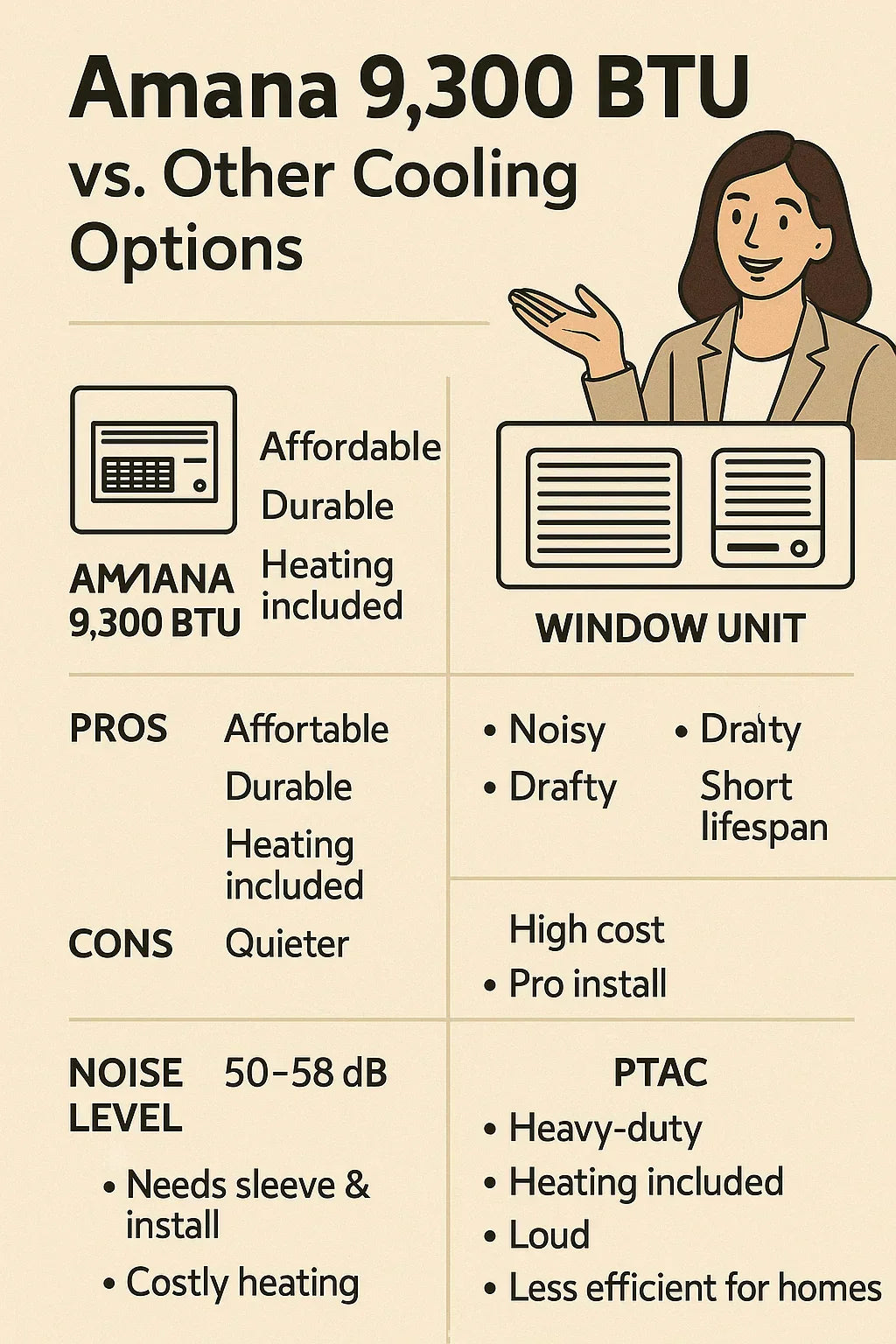When it comes to cooling and heating a single room, homeowners face a tough question: which system is the best investment?
Do you go for a through-the-wall unit like the Amana 9,300 BTU, stick with a budget-friendly window AC, invest in a highly efficient mini split, or go hotel-style with a PTAC?
Each option has its own strengths and drawbacks — and choosing the wrong one can leave you with higher bills, more noise, or a shorter lifespan.
That’s why I (Savvy) am breaking down exactly how the Amana 9,300 BTU stacks up against its most common competitors. By the end, you’ll know which system makes sense for your home, your budget, and your comfort priorities.
🧊 Quick Overview of Each Cooling System
✅ Amana 9,300 BTU Wall AC/Heater
-
Best for: Small to medium rooms (350–450 sq. ft.)
-
Features: Cooling + electric heat, permanent wall install, remote control.
-
Strengths: Durable, quieter than window ACs, affordable mid-range option.
-
Weaknesses: Requires installation accessories, heating is expensive to run.
🪟 Window Air Conditioners
-
Best for: Renters, short-term solutions, or tight budgets.
-
Features: Quick DIY install in windows, wide BTU range.
-
Strengths: Cheapest upfront, easy to install/remove.
-
Weaknesses: Noisy, drafty, short lifespan.
❄️ Mini Split Heat Pumps
-
Best for: Homeowners wanting maximum efficiency and quiet operation.
-
Features: Indoor air handler + outdoor compressor, ductless design.
-
Strengths: Ultra-efficient (SEER2 20+), whisper quiet, heats & cools.
-
Weaknesses: High upfront cost, requires professional installation.
🏨 PTAC Units (Hotel-Style)
-
Best for: Hotels, apartments, commercial settings.
-
Features: Heavy-duty, built for constant use, wall-installed with sleeve.
-
Strengths: Rugged, long-lasting, provides heating and cooling.
-
Weaknesses: Louder, less efficient for residential homes, pricier upfront.
📏 Sizing & Coverage
Cooling performance starts with the right size.
-
Amana 9,300 BTU Wall Unit: Perfect for 350–450 sq. ft., like bedrooms, offices, or small living rooms.
-
Window Units: Available from 5,000 to 25,000 BTUs, but efficiency drops at larger sizes.
-
Mini Splits: Offer a wide range (9,000–24,000+ BTUs) and can cool multiple rooms with zoning.
-
PTACs: Typically 9,000–15,000 BTUs, designed for single large rooms like hotel suites.
👉 U.S. Department of Energy stresses that oversizing wastes energy, while undersizing leaves you uncomfortable
💰 Upfront Costs
Here’s what you can expect to pay:
-
Amana 9,300 BTU Wall Unit: $800–$950
-
Window AC Units: $300–$600
-
Mini Splits: $1,500–$3,500+ (installed)
-
PTAC Units: $1,200–$1,800 (including sleeve & grille)
At first glance, the window unit looks cheapest. But remember — upfront cost isn’t the whole story. Efficiency, lifespan, and installation complexity all play a role in the long-term value.
⚡ Energy Efficiency & Operating Costs
Amana 9,300 BTU Wall Unit
-
Cooling efficiency: Mid-range (EER ~10–11).
-
Heating: Uses electric resistance heat → expensive to run in winter.
Window AC Units
-
Efficiency: Lower, often EER 9–10.
-
Bills: Can add up quickly in hot climates due to energy loss around the window.
Mini Splits
-
Efficiency: SEER2 18–24, the best on the market.
-
Bills: Lowest operating costs, especially for year-round heating & cooling.
PTACs
-
Efficiency: Typically EER 9–12, designed more for durability than efficiency.
-
Bills: Higher than mini splits, similar to wall units.
👉 According to ENERGY STAR, mini splits can save 30–40% on energy bills compared to room units
🔇 Noise Levels & Comfort
Noise can make or break your comfort.
-
Amana Wall Unit: 50–58 dB → quieter than window units, comparable to PTACs.
-
Window Units: 55–65 dB → loudest, compressor vibration is noticeable.
-
Mini Splits: 19–30 dB → whisper quiet, perfect for bedrooms.
-
PTACs: 55–60 dB → steady hum, often too loud for bedrooms.
👉 Consumer Reports identifies noise as the #1 complaint about window ACs
🏠 Installation Complexity
-
Amana 9,300 BTU Wall Unit: Requires wall sleeve, exterior grille, 230/208V outlet → pro install ($300–$1,000).
-
Window Units: DIY install in minutes → but blocks window use.
-
Mini Splits: Professional installation mandatory, $2,000+ cost.
-
PTACs: Similar to wall units, requires sleeve & pro install.
👉 ACCA stresses that professional installation improves efficiency and lifespan
🧾 Long-Term Value
Amana 9,300 BTU
-
Lifespan: 10–15 years.
-
Balance of price and performance.
Window AC Units
-
Lifespan: 5–7 years.
-
Cheaper upfront, but “disposable.”
Mini Splits
-
Lifespan: 15–20 years.
-
Higher upfront cost, but best long-term ROI.
PTACs
-
Lifespan: 10–15 years, rugged, but less efficient for home use.
⚖️ Pros & Cons Table
| System | Pros | Cons |
|---|---|---|
| Amana Wall Unit | Affordable, durable, heating included, quieter than window ACs | Needs sleeve & pro install, costly heating |
| Window Unit | Cheapest upfront, easy DIY install, wide availability | Noisy, drafty, short lifespan, blocks window |
| Mini Split | Ultra-efficient, whisper quiet, long lifespan, zoned comfort | High upfront cost, pro install only |
| PTAC | Rugged, hotel-grade, good for heavy use | Louder, less efficient for homes, higher cost |
✅ Conclusion: Savvy’s Take
Here’s how I see it:
-
If you want balance → The Amana 9,300 BTU wall unit is the sweet spot. Affordable, long-lasting, quieter than a window unit.
-
If you want cheap & temporary → A window unit makes sense, but don’t expect it to last or stay quiet.
-
If you want silent & efficient → Go for a mini split. It’s pricey upfront, but the savings and comfort are unmatched.
-
If you want rugged durability → A PTAC works, but it’s overkill (and often too loud) for most homes.
The Amana 9,300 BTU stands out as the practical middle ground — better than a noisy window unit, more affordable than a mini split, and more efficient than most PTACs for residential use.
In the next topic we will know more about: Is 9,300 BTUs Enough? Sizing Your Amana Wall AC/Heater for Small to Medium Spaces







